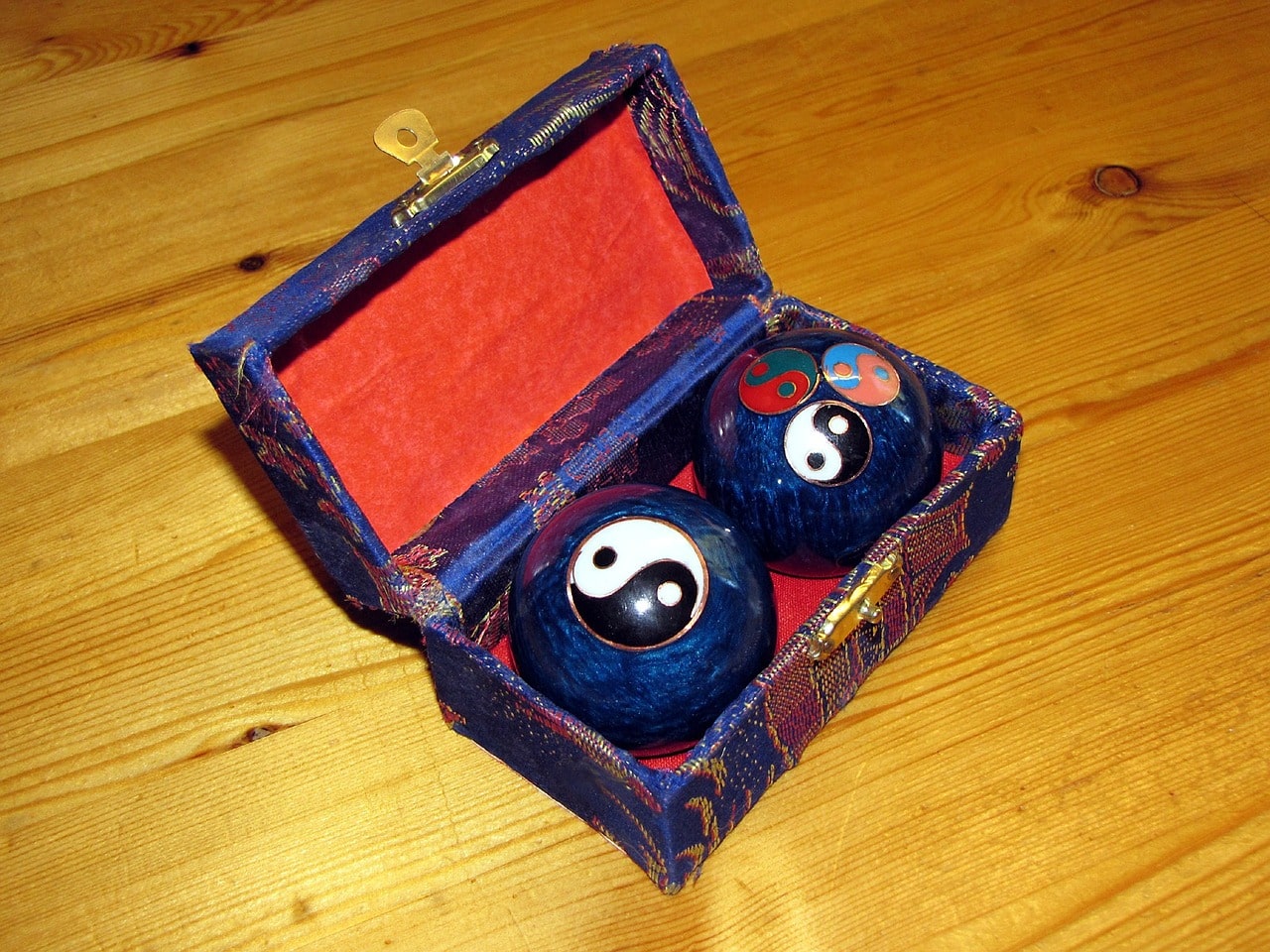
Why Chinese medicine balls very popular? As we all know, yoga is an excellent form of meditation that helps strike a balance within different parts of our body and helps keep us fit. Ever came across Baoding balls, or better still, the Chinese meditation balls or health balls? How the feeling like in your hands was, felt good right? Yeah, I guess that’s a Baoding ball for you.
Yoga isn’t just about the joints, muscles, and significant parts of our body, but it also hits other parts like the hands, for instance. I know you’d be wondering, like how is yoga also for the hand or how is the hand yoga done? Don’t you worry, we’ve got it all covered for you in this article.
Baoding Balls Chinese Health Exercise Stress Balls, Chrome Color
What’s a Chinese medicine balls?
Also called the Zen balls, Chinese exercise balls, Chinese meditation balls, Chinese therapy balls, the Baoding balls are small metallic balls held in the palms. They’re believed to have come from Baoding China, a little town in the Heibei province which was in existence during the Ming dynasty. These balls are utilized by turning at least two balls over and over in hand to improve mental capacity and finger mastery, recovery of muscle strength and engine abilities after a medical procedure, and likewise to loosen up the hand.
Medicine balls today also have some beneficial effects as the western stress balls. They’re primarily used to put pressure on chi points in your hand and provide a smooth hand and wrist exercise. Some believe that the Baoding balls aid in reducing stress, in which case they’re termed “worry balls.” Though it might be distracting to rotate these balls during a meditation class where your main focus is on the mindfulness of your breath, they can also serve as an adjunct to actual sitting meditation practice. Also, you can check What is the best Yoga music for relaxation and meditation?
History of Chinese medicine balls/Baoding ball
Chinese therapy balls or Baoding balls date back to the Ming dynasty. They’re accepted to have started from a modest community of Baoding in the North China plain. Guess that’s where the name was gotten from and is one of the “Baoding Treasures.” Most of these meditation balls are still manufactured in the area and were formerly made of iron.
Before the emergence of Baoding balls, soldiers and the public exercised their hands with walnuts by rolling them around. This practice continued until iron Chinese medicine balls which doubled as weapons, were manufactured.
Today, Zen balls come in different sizes and materials like stone, jade, and chrome. Some are made of hardened steel and are empty inside. When tossed around, they tend to produce a pleasant chiming sound. These balls vary in weights and textures, and their coatings are of unique designs. The amazing hand-made designs that decorate some Baoding balls portray characters and symbols associated with harmony, health, wellness, and many other positive forces.
Baoding balls manufactured from stones are much heavier than others, and most persons use them to exercise their hand muscles. These stone balls need to be handled with care since they tend to break or chip when dropped.
How to use a Chinese medicine balls?
Using Chinese medicine balls or a Baoding ball is as easy as tossing a coin. It’s highly recommended that newbies start with more petite balls before advancing into more giant balls as the skill level increases. Start with two balls and do what feels natural to you.
Move the ball around your hand in a way that feels more satisfying to you as this sends positive signals to the brain, making it easier to let go of thought which makes you worried or anxious. After this, try circulating the ball in one direction, after which you do the same for the opposite direction. Try spreading the balls in either direction and when you’re more experienced, see if you can circulate them without them touching each other.
Chinese medicine balls Dark Grey Health Exercise Stress Hand Balls Natural Chinese Health Medicine Marble Balls
Here’s a step-by-step guide to mastering the basic rotation of Baoding Balls.
- When starting, it’s best to choose a smaller set of balls, let’s say below 40 mm diameter. If you’ve got wider palms like mine, then something above 40 mm would be a go. You may have a preference, but take what you feel comfortable using.
- Hold the balls with a bit of space between your bodies. Observe the heaviness of the ball in your grasp. You will not get a good reaction when one drops on your feet, so be careful. To stay away from mishaps, remain on a table or get your hand far from your body. Please don’t use the balls as a tool to crack other stuff or as a nut breaker, and don’t use it over glass either.
- Turn the Baoding balls with your fingers. The revolution aims to have the balls trade places. With the use of your thumb, push the furthest ball towards your body, and at the same time, utilize your fingers to move the other ball to your more giant fingers. Keep turning the ball in your grasp as long as you can.
- Take a step by circulating the balls in your palm until you can do it quickly. As you get further into the training, the balls will doubtlessly crash into one another less and less. If the ones you’ve purchased have got chimes, listen to hear them ring smoothly and without interruption. Once this happens, you’re through with the basics and now a master of it. You can choose to continue practicing till the balls don’t even touch each other at all.
Learning advanced tricks with the Chinese medicine balls.
- Rotate the ball with less finger contact. As you get acquainted with the use of the balls, you’ll oversee your muscles. Instead of making use of your fingers, set the balls in your palms and try rotating them. Raise one part of your palm, and then try lowering the other part so the ball can start rolling. It’s somewhat tricky, but the level of strength and concentration learned is an excellent package.
- Try turning your palms downwards while circulating the balls. The angle at which you hold your hand can make the use of the ball much harder. You’re to have your hands flat on a norm, but try raising it upwards a little. The more your hand faces the ground, the more work you’ll need to do on your muscles to control the ball.
- Move the balls in the opposite direction. Instead of moving the balls in the direction of your thumb, try sending them towards your little fingers. Rotate the balls in your hand as you would typically do. It’s a fundamental trick which at times, feels difficult on your first trial.
- Try using more balls. Begin with a third ball. Once you’re a pro in it, add the fourth. Spin them in your hand the same way you did the two. The difficulty of using the ball might increase with more balls but so also your skill level.
- Advance onto bigger balls. These balls are tougher to handle. They’re much heavier and are preferable by some practitioners. It can even serve as a new challenge when you’ve mastered the meditation balls you own.
Benefits of using a Chinese Baoding ball
Baoding balls have been used for centuries by the Chinese, and there’s a good reason for that. Doctors in China sometimes recommend Baoding balls to patients suffering from fatigue. These balls have a way of activating various therapeutic pressure points found in hand. By doing this, the internal energy flow of the patient is enhanced.
The surface of some of these balls has tiny bumps. When these bumps get in contact with the skin, their pressure is said to enhance blood circulation. Zen balls are also used for various forms of physical therapy, especially when trying to exercise muscles around wrists, hands, and arms and improve agility. Some persons even noticed that prolonged use of the Chinese meditation balls improves memory and sharpens the intelligence.
In conclusion
The movement of some muscles in your hands helps release some stored stress, and the rhythmic motion of circulating the Chinese medicine balls on your hands has a significant effect on your hands. Try getting your set of Baoding balls today and use them. It’s something you can do to keep yourself involved and not pondering what makes you pushed. They may not seem like much, but you might not know – the best things come in small forms also.











